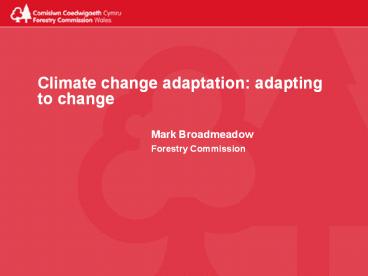Climate change adaptation: adapting to change - PowerPoint PPT Presentation
1 / 23
Title:
Climate change adaptation: adapting to change
Description:
We've been around for millennia, so why have we only got ten years to ... Provenance matching' Oceanic climate. Frost risk 2 degrees south. Portfolio approach' ... – PowerPoint PPT presentation
Number of Views:439
Avg rating:3.0/5.0
Title: Climate change adaptation: adapting to change
1
Climate change adaptation adapting to change
- Mark Broadmeadow
- Forestry Commission
2
Why do we need to adapt?
Weve been around for millennia, so why have we
only got ten years to save the planet?
3
Climate matching - Brechfa
4
The rate of change
feet per day
5
ESC suitability change Sitka spruce
2050 Low
2080 High
2050 High
6
Changing distribution of ash
1961-90
2020s
2050s
2080s
ECI/BRANCH project www.branchproject.org.
7
ESC suitability for NVC woodland
1961-90
2050s High
2050s Low
8
Unforeseen and extreme events
9
Dont forget there are opportunities
10
What do we want to protect?
11
(No Transcript)
12
Adaptation - dont put all the eggs..
13
What are the options?
14
Make existing ecosystems more resilient
- Manage existing woodlands better - promote
regeneration and reduce other pressures - deer management
- fire management plans
- wind hazard management
- Enlarge existing woodlands
- Create habitat networks to encourage natural
adaptation/evolutionary processes - Relax designations to reflect likely changes in
community structure that will still form
functional woodland ecosystems
15
Changing species range beech
16
Enhancing resilience of native species
- Redistribute native species within the
site/landscape/country - ie amend species choice - Diversify species composition
- mixed species stands, including for commercial
timber production - diversification within wood/forest/landscape
- Use seed origins from more southerly regions
17
Utilising the available genetic resource
Grimsthorpe - England
Slovenia
Dunnottar - Scotland
- Encourage regeneration and natural selection
- Provenance matching
- Oceanic climate
- Frost risk gt2 degrees south
- Portfolio approach
18
Non-native species
- Productive plantations
- commercial timber species for which we have
(limited) silvicultural knowledge (Nothofagus
Eucalyptus black walnut pinaster pine). - New native and amenity woodland
- small component of native species dominated
mixture - main component of 'new ecosystems
- from continental Europe - where they are
components of functional ecosystems alongside our
native species - careful consideration required of impacts on
native species and woodlands - hybridisation
- pests and diseases
- invasiveness
But.......evidence not sufficient and unlikely
to be necessary in Wales
19
Species choice in the urban environment
20
Alternative approaches to management LISS
- Species diversity
- Structural diversity
- Regeneration capacity
- regular regeneration provides insurance
- less hostile environment
- encourages natural selection
- Windfirm?
- If not, next cohort present Encourage
regeneration and natural selection
21
Protecting the genetic resource
- Create refugia for species under threat
- Create refugia for identifiable genotypes/races
under threat - conserve genetic diversity - Use arboreta/collections as global repository of
genetic material
22
Barriers to effective adaptation
- Uncertainty
- The level and rate of change predicted
- Pests and diseases
- Extreme events
- Some current concepts of nature conservation
- An understanding of new assemblages
- Competing policies
- Complacency
23
Conclusions appropriate actions
- There are options we can take now
- The sector needs to act soon to ensure a resource
for future generations - We should only implement no or low regret
measures - Diversification insures against uncertainty
- Some higher risk actions may be prudent
- Above all, we should not panic........
- .........but take the opportunities climate
change presents































